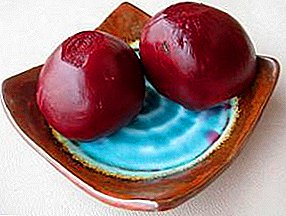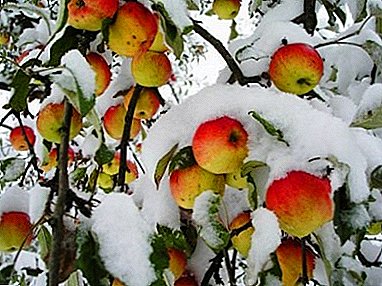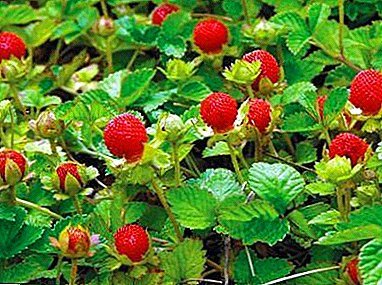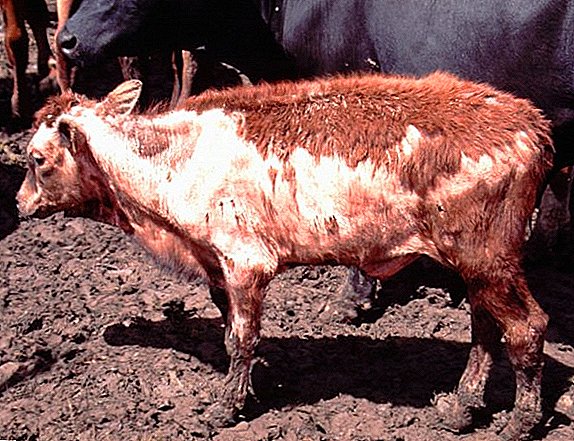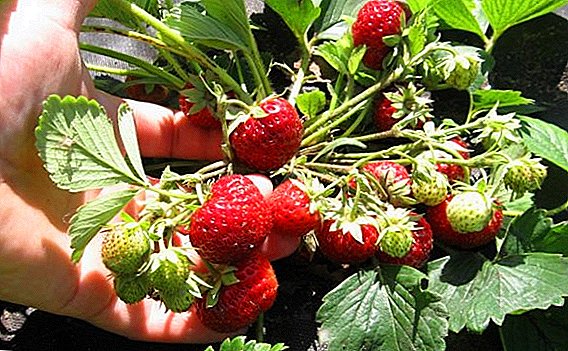 A good neat lawn without weeds and bald spots is the dream of any homeowner. But those who tried to set up a “primitive” green lawn on their land, know how difficult this task sometimes is. Lawn grass requires serious preparation of the site before planting, and further care of the seedlings (watering, cutting, weeding, etc.) is no less, and sometimes more complicated, than the garden and garden. Of course, an important place in the agrotechnology of creating a beautiful lawn is the correct choice of the main plant. One of the possible options for lawn grass - meadow fescue.
A good neat lawn without weeds and bald spots is the dream of any homeowner. But those who tried to set up a “primitive” green lawn on their land, know how difficult this task sometimes is. Lawn grass requires serious preparation of the site before planting, and further care of the seedlings (watering, cutting, weeding, etc.) is no less, and sometimes more complicated, than the garden and garden. Of course, an important place in the agrotechnology of creating a beautiful lawn is the correct choice of the main plant. One of the possible options for lawn grass - meadow fescue.
Biological features
Meadow fescue is a perennial rather tall grass from the family of semi-chained cereals with a very strong root system. Practically in all descriptions of this plant its high frost resistance and fast regrowth after mowing is noted. 
It has numerous direct generative stems, as well as short vegetative, the number of which increases sharply from frequent mowing. The leaves are long and wide, glossy at the bottom, beautiful and rich green color. If you do not shear the grass in time, it forms spikelets in the form of panicles, at first compressed, but scattering during the flowering.
Among the features of the plant should highlight the structure of its root system. Part of it is located in the surface parts of the soil, has a strong creep and serves to nourish the plant. Such roots are thin and live for one season.
Sizaya fescue is also very popular in design.
The second part of the root system of the perennial perennial roots is thick, which extends vertically deep into, strengthening the plant and at the same time providing it with excellent drought resistance and ability to survive the severe frosts, as well as spring frosts.
Fescue gives a good growth in the first year of life, however, the above-mentioned generative shoots start to appear only from the second year. After 2-3 years, the plant matures and can live for about eight years.
Important! When creating favorable conditions, the average life expectancy of meadow fescue can be doubled.

Speaking about the winter hardiness of the plant, it should be noted that, feeling good under the snow, meadow fescue can easily die if after a thaw an ice crust forms on the surface of the ground. Also, this grass does not like sudden changes in temperature in the offseason.
But the abundance of water in the soil after intense thawing of snow, it carries great, even if the moisture stagnates for more than ten days in a row. Such a lawn will survive the drought, but it will look more scarce (the number of vegetative shoots of the grass during the dry period is reduced).
Meadow fescue is widely distributed as a lawn crop, but it is necessary to create suitable conditions for it, since unpretentious this plant is difficult to call. In addition, such lawns necessarily need to regularly cut, because, as seen in the numerous photos, the neglected area with high sprawling spikelets very quickly acquires a sloppy and unattractive appearance.
Did you know? One of the most beautiful lawns in the world is located in the capital of Australia, in front of the parliament building. The number of sprayers for its irrigation is about eight thousand, through which one and a half hundred thousand liters of water passes daily. However, the Australians managed to create a magnificent lawn, even on the roof of a government building. In this case, it remains only to guess how much force is needed to maintain it in such an ideal state.
The advantages and disadvantages of such a lawn
So, the plant as a lawn grass is not suitable for everyone, so it is very important to clearly know what kind of landscape you are going to create, what initial conditions for this you have.
pros
Among the absolute advantages of perennial The following should be highlighted:
- with proper sowing, in the first year of life the lawn will look completely covered with bright green grass, without ugly bald spots;
- a lawn of such grass forms a very beautiful, smooth and fluffy;
- the plant rises in record time, literally seven days after sowing, and after a month the lawn becomes evenly green;
- having spent once the necessary amount of effort and providing the plant with the minimum necessary care, you can create a lawn that will last for a decade and a half or even longer;
- such a grass, thanks to strong roots, will easily endure a harsh winter and do without watering even in fairly dry weather, if, of course, we are talking about a week or two, not months. (Therefore, fescue is a good choice for planting in summer houses where the owners do not live, and happen on short visits);
- frequent mowings do not harm the plant, but only improve the appearance of the lawn, while the beveled stems are soft and not prickly;
- annual grass roots grow remarkably horizontally, due to which the lawn is literally drawn in front of a dense green mass;
- fescue can grow well in sunny areas where other herbs dry quickly and turn yellow;
- weed is very well suited for those who want to create a smooth and beautiful coating between the trees.

Minuses
Fescue meadow completely not suitable for elite lawnswhen the designer aims to get the perfect emerald grass cover, similar to the expensive Persian carpet in the main hall of the royal palace. On such a lawn, as they say, it does not break, but sinks in a gentle, like fluff turf, an egg if tossed from a height of half human height. The heroine of our story will not allow creating such an effect, it is easier for sites.
Important! If you plan to use a beautiful lawn to install sun loungers or hold active games, you need to use some other grass for this. Meadow fescue looks good only on the lawn, which does not go.And this is perhaps the main drawback of this grass, because country cottages usually have too little space to allow themselves the luxury of arranging a green lawn only to admire it from afar.
If you compare the fescue with other lawn grasses, it should be noted that caring for her is quite complicatedYes, and to the composition of the soil the plant makes quite high demands. To make the lawn look attractive, it is very important to sow grass in early spring, only in this case it will have time to form a good root system and enter the winter properly.
Finally, as already mentioned, such lawns need to be cut regularly, otherwise they quickly lose their attractiveness, moreover, the grass begins to clump up from the germination of falling seeds, all the uniformity of coverage will be hopelessly lost.

Thus, for the so-called Moorish lawn - the dream of a lazy summer resident - this grass, unfortunately, is of little use.
Did you know? While prim Europe has long preferred landscape design, represented by neatly clipped lawns, where each blade of grass, thanks to the work of numerous gardeners, is strictly the same length, the Moorish lawn, the appearance of which is associated with the influence of the oriental taste of caliphs and emirs, is a variegated grass of field flowers , which almost did not touch the garden shears and scythes. The fashion for Moorish lawns began to penetrate into Europe at least a thousand years ago.In fairness it should be noted that a certain part of the disadvantages of using meadow fescue in landscape design can be partially corrected by mixing it with other lawn herbs.
Application in grass lawn mixtures
Meadow fescue is used in different lawn mixtures, the composition of which depends on the role they play in landscape design. In this case, most often this grass is still acts as the main plant. However, if, for example, we are talking about the arrangement of a summer barbecue area, the festivity should be added to the lawn mixture in a minimum quantity, since, as already mentioned, as a result of trampling, it completely loses its decorative effect.

On the contrary, the predominant role of this grass can be given to the decorative design of borders or to separate one area of the site from another, as well as to design the carpet between fruit trees.
Important! To mix meadow fescue with other herbs with caution, because this plant is very fond of the sun and does not tolerate competitors in the fight for a place under it. Therefore, if the conditions on your site are suitable for this herb, it is better to use it in its pure form, without mixing it with anything.If for one reason or another it is still necessary to dilute the fescue, for these purposes red and white clover are often used, timothy meadow, as well as the meadow bluegrass and long-term reissue grass very popular in our latitudes. For example, a classic landscape gardening mixture consists of pasture rayhgassa and meadow fescue in the ratio of 3: 2.
For the same purpose, another mixture will be suitable (it is also called “universal”): meadow bluegrass, one-year and pasture meadowgrass are added to the meadow fescue in a ratio of 6: 1: 1: 2. For shady gardens, a mixture consisting of red fescue, as well as one-year-old rigassa (the usual ratio is 3: 6: 1) is better suited.
If it is necessary to create a lawn in highly dusty urban conditions, take two parts of meadow fescue: 4.5 parts of timothy grass, 2 parts of one-year rigasse, 2 parts of hedgehogs of the national team or 4 parts of timothy grass and 2 parts of one-year and pasture grasses, or 8 parts raigassa grazing and 2 parts of the annual and 4 parts of timothy meadow.
Choosing a place
The pledge of a beautiful lawn is a well-chosen place, ideal for the main plant. Meadow fescue, as has been said, feels great in sunny areas and makes quite high demands on the soil.
Did you know? It turns out that a lawn is not only fashionable and beautiful, but also very useful. Firstly, doctors have proven that the green color has a calming effect on our nervous system, so looking at the green lawn at the house, we thereby relieve ourselves of the effects of stress and tension. Secondly, ordinary grass perfectly absorbs dust and absorbs urban noise, which is especially important in conditions of poor ecology.It is no exaggeration to say that we are dealing with a connoisseur of fertility. Dry soil is bad for this grass; sandy soil is not the best option. But with great gratitude the perennial will respond to sandy, loamy soil or loamy soil rich in humus. Soil acidity can vary in the range of 5-6, and soil salinity tolerates better than the above-mentioned timothy meadow.
Site preparation
If you want to have a beautiful lawn, do not expect that it will be formed by itself. Those who, having bought a dacha, overgrown with green grass to the waist, decided that it was enough to cut it and pour some grass mixture acquired in the nearest supermarket, and he would get the lawn from the picture - he was cruelly mistaken.

Another issue is that this problem can be solved in different ways. The first, most familiar - digging. Second - chemical attack. In the first case, you spend more energy, in the second - paradoxically, more time, because you can sow new grass no earlier than 1.5-2 months after treatment, and during this period you will watch the sprouting sprouts of new weeds, which it will be necessary to delete already manually.
In addition, the grass killed by poison still needs to be raked and removed from the site, therefore, in any case, it is impossible to do without serious physical labor. If you decide not to resort to chemistry, you do not need to dig up the earth, and only remove the top layer of turf from it - grass along with its roots.
At the same time, such a grass can be used wonderfully: select a small area for this business and fold the removed grass layer with its roots up. It will take a couple of years, the plant will rot, forming a completely new fertile land suitable for use in agricultural work.
Important! No matter how strange it may seem, before planting grass on the plot, it is necessary to ruthlessly remove what is already growing on it.
In addition to vegetation, you need to remove all rubbish, stones, bricks, remnants of concrete from the plot, otherwise you will not see a beautiful and uniform lawn. The cleared site should be leveled and feed the earth. It is better to use for this special fertilizer for lawn grass. The final stage - trampling down the area and easy loosening.
Land for the lawn should not be like fluff, but large clods must be broken. The plot prepared in this way is best left alone for some time, so that the earth naturally subsides and the remaining weed roots in it appear.
Sowing seeds
Meadow Fescue best sow springonly in this way the grass will have time to gain a foothold. For germination, it is enough that the external temperature is literally a couple of degrees over zero. Seeds retain their similarity for a long time, with proper storage - up to five years.
The seeding rate on average - 100 g per hundred, but with long-term storage, this number can be increased. The depth of seeding into the ground depends on the mechanical composition of the soil: on heavy soils, it is enough to dig a groove of 1-1.5 cm, on medium and light depth should be increased, respectively, to 2 and 2.5 cm.
After the seeds fall asleep, the grooves are buried with a rake, after which the site is compacted with the feet or a special roller (roller) for rolling the lawn. At the initial stage, the lawn should be watered with a moisture spreader so as not to damage the young shoots.
Lawn care
If the first condition of a good lawn is thorough preparation of the site, then the second is correct and regular maintenance. If you want to have neat green grass around the house and at the same time do not intend to spend your time on it, buy an artificial (synthetic) lawn. Lawn grass is not a weed at all, which grows on its own. However, even weeds in arid summer quickly turn into deadwood, what to speak of ornamental plants.
When using a lawnmower for mowing the lawn, you can also make mulching, which will allow you to retain moisture.
Especially careful care requires a young lawn. No matter how much it says about the drought-resistant qualities of meadow fescue, it should be borne in mind that you can seriously rely on them no earlier than from 2-3 years after disembarkation.
At first, the grass tolerates drought very hard, especially if you are at least a little late with the sowing. As already mentioned, in the first year the root system is not yet developed, and this process is very slow. It is full watering and regular haircut will ensure the accelerated formation of turf - the root system of our lawn.

But having survived the first year, the fescue still needs to be remembered. At this and subsequent stages lawn care consists of the following activities:
- March: we check the condition of the lawn after the winter, if necessary, carefully level the formed depressions so that the melt water is distributed over the section evenly;
- April: we feed the lawn with mineral additives (special attention is paid to nitrogen, potassium and phosphorus);
- May: we remove the garbage that has accumulated on the site and the so-called felt - remnants of cut grass, dry stems and leaves. Remember: felt - a dangerous enemy of the lawn: it does not allow the grass to breathe and, in addition, disfigures the appearance of the lawn. After cleaning, we carry out the first lawn mowing;
- June: another haircut and another alignment area;
- the rest of the summer: cutting, regular watering and fertilization;
- September: watering is gradually reduced, we feed the earth with phosphorus and potassium. Nitrogen at this time should be excluded, because it stimulates the growth of grass, and we at this stage do not need it;
- October: the final haircut, it differs from the previous ones in that in the winter it is necessary to leave at least 5 cm of grass, cleaning and airing (slightly loosen the top layer of soil with a rake). At the same time, carefully examine the lawn and, if there are signs of fungal diseases, treat them with a systemic fungicide;
- In winter, lawn care is needed only if it is covered with an ice crust: such a crust needs to be broken, otherwise the grass will die under it.

Important! Only after the formation of a dense turf layer does the lawn become resistant, can independently fight weeds, tolerate frost and drought.As you can see, meadow fescue is a good choice for those who want to create a beautiful lawn, but to achieve a good result, it is important to know when this plant is undesirable and to follow all the rules of caring for it.




